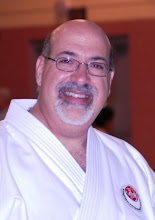I am the Sensei or teacher in this class and I hope that you have a wonderful experience that will help you to enjoy martial arts as much as I do! That is how I greet new students. Of course, it may not be verbatim but you get the idea.
In the first class at my dojo, there are many things that you will learn. You will learn some of the history of the Shotokan Karate and some of the principles or precepts that come with our style (also known as the dojo kun). The amount of
.jpg) time spent discussing these things depends upon the age of the student, and their attention level. Younger students get a little less history at a time, since they have a shorter attention span. As we progress through the traditions of our class-like rei-ing in (bowing in), we discuss those too.
time spent discussing these things depends upon the age of the student, and their attention level. Younger students get a little less history at a time, since they have a shorter attention span. As we progress through the traditions of our class-like rei-ing in (bowing in), we discuss those too.It is important not to overload any student. So I keep a good watch on the student's expressions and body language. After all, my goal as a teacher is to inspire and ignite a passion for the martial arts. So I don't want to talk too long, as I don't want to lose them. So after a bit of talk about history, dojo rules and traditions we begin training.
It is customary in my dojo to warm up with some stretching. It doesn't matter if it is a beginning class or a more advanced class. Then I introduce some techniques. While demonstrating the techniques, the proper form is explained. I try to pattern my teaching after the way I was taught by my Sensei. I give a lot of encouragement to my students. As time goes on with a student, a balance is reached that includes encouragement and constructive feedback. During a first class, though, we concentrate on encouragement.
The first techniques that are learned in my dojo are dachis (stances). Our foundation is built upon our connection to the earth and so it is very important that we are able to stand correctly. We generally cover just the most basic of stances in terms of practicing those techniques, although some of the others to be taught later are demonstrated. We spend some time practicing what we have learned and then we learn to walk using the stances. Usually, I concentrate on moving in zenkutsu dachi (forward stance) since it is one of the most commonly used stances.
Moving into the next technique, I teach a choku zuki - straight punch. After a bit of practice in slow motion, we speed it up a bit. Then we are ready to try to put stance, movement and strike together. So we drill with our zenkutsu dachi (forward stance) and walking, rooting ourselves and then executing choku zuki - straight punch.
The first class with a student usually consists of these things and bowing out ceremony. On paper, this may not seem like it would take a great deal of time, but it actually works out to be about one class period. Of course it depends upon the age of the students, whether or not they learn quickly and various other factors.
Students are welcome to stay after and ask questions. Sometimes we spend a little bit of time processing what is learned and I encourage them to practice daily. I am also open to being called if there are more questions that come up later and email is always an option. My purpose as a teacher is to pass on what I know and my love of the art. It is my mission and passion. I look forward to teaching each person who takes the time to come to my dojo. Hopefully, the experience they have with me will inspire them to continue into the do (way of life) and enhance their life.

